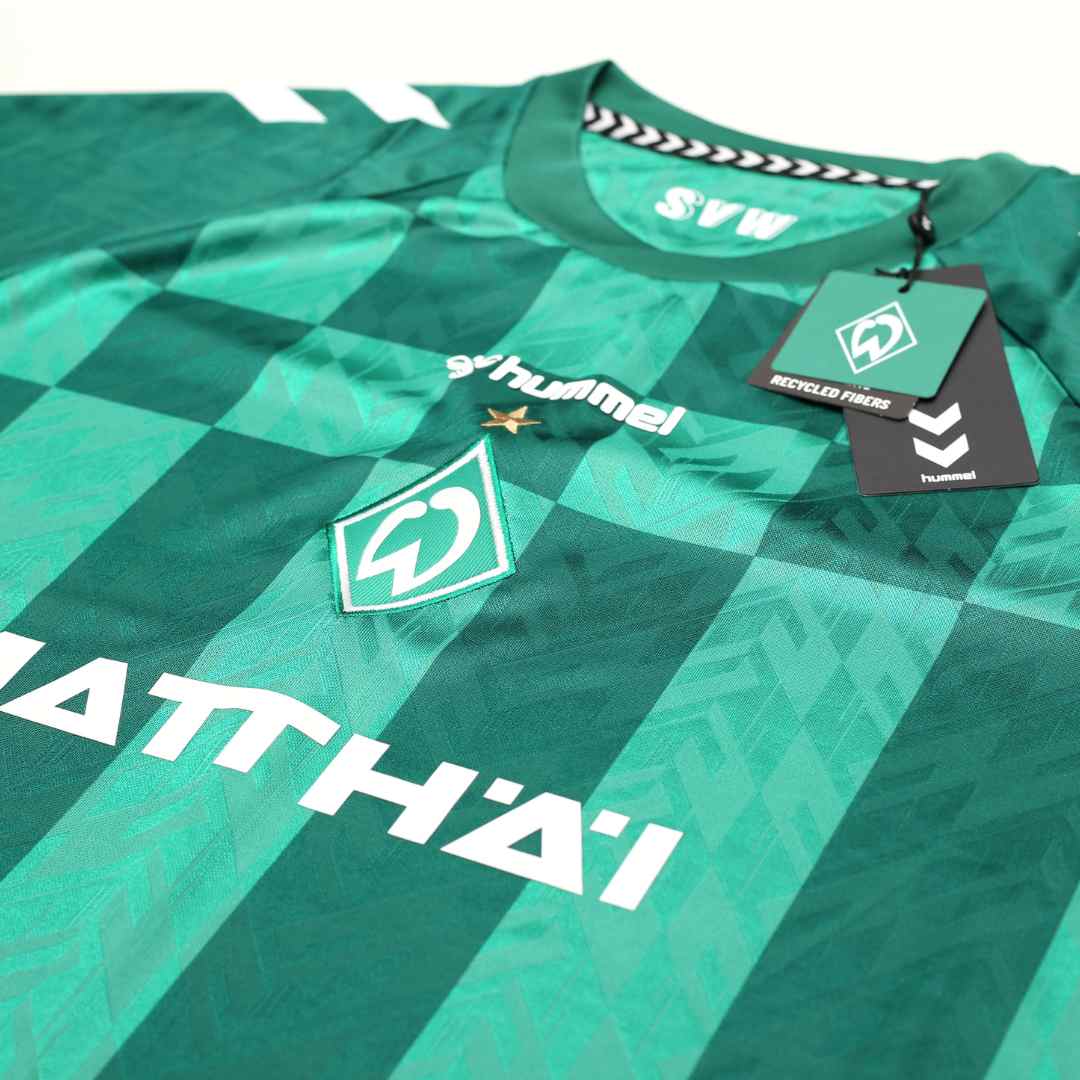rated excellent on trust pilot | Returns accepted | pay in 4
rated excellent on trust pilot | Returns accepted | pay in 4
Recently added
Vintage shirts
Concept kits
Legends

Blackout Kits: What next?
by Phil Delves February 28, 2022 6 min read
Blackout kits and the future of anniversary shirts
Last week, Borussia Mönchengladbach joined an exclusive list of clubs who have created a special ‘blackout’ kit.
Borussia Mönchengladbach joined the black-out club at the weekend 🖤🖤🖤 pic.twitter.com/oChgCwFaBb
— Football Shirt Collective (@thefootballsc) November 3, 2020
The microtrend of entirely (or almost entirely) black kits has been steadily building pace since the start of 2018, when Swedish club AIK rolled out an all black ensemble in partnership with Nike.
🤤 ⚫ AIK have released their limited edition black out Nike kit
— The Sportsman (@TheSportsman) January 21, 2019
Words can't describe my feelings for this... pic.twitter.com/iil7KZAlh3
Even though the kit community was considerably smaller at the time (we’ve come a long way in 2 years!). The release was a notable moment in modern shirt history. From an aesthetic point of view, AIK and Nike played things to perfection by fully committing to the look, and in true limited edition fashion the club website crashed under the weight of people rushing desperately to pick one up.
Such was the success of the launch that the club repeated the trick both last year and this year, with a further blackout design and two more special edition kits on the white end of the spectrum.
If the 2018 AIK blackout kit got the ball rolling, Germany giants Borussia Dortmund picked up that ball and ran with it.
In a stunning turn of events, Dortmund and Puma produced a blackout shirt of their own in 2019, without providing any sort of heads up. The hype that surrounded the shirt was as close as what we saw to what we saw with Nigeria in 2018, and like AIK before them the club shop emptied as quickly as it was filled. Fake sites were subsequently flooded with shameless imitations of the kit, and still to this day you’ll find many accounts on Twitter claiming to be offering you the chance to win the kit if Jadon Sancho scores first in Dortmund’s next game.
Even the likes of Torquay United got in on the blackout act in 2019 (actually beating Dortmund to the punch by a week…), with a design bearing striking resemblance to AIK’s 2019 blackout kit.
Throughout the past couple of years, we also saw a spate of blackout designs released not as match shirts, but as kits more akin to what you’d see in a lifestyle collection. The most notable of these came from Liverpool, who went back to back with New Balance creating black recolours of their home kits in 2018 and 2019.
Liverpool have unveiled their new blackout limited edition shirt. ⚫️🖤⬛️ pic.twitter.com/sFxM0WLOk8
— Football Tweet ⚽ (@Football__Tweet) August 28, 2019
The good side of the blackout kit
What are we to make of this microtrend? Is this just a shameless attempt by clubs and brands to grab some extra cash, or is there more to it than that?
If we start with the AIK shirt of 2018, the all black aesthetic was actually grounded in the history of the club. As far back as 1901, the club opted for a fully black kit, and the team have stuck with black as their primary colour ever since (usually in combination with yellow details). As such the blackout design wasn’t completely out of the blue, and though the shirt wasn’t strictly speaking an anniversary shirt its historical links justified the approach somewhat.
Other blackout kits have less concrete, though still acceptable, links. In the case of Dortmund, the club suggested that the design was made as a nod to the coal industry in the region. Often these sorts of stories can appear increasingly tenuous the further you dig down into them, but in fairness to the club and Puma, the shirt was released just 1 year after the final coal mine of the region closed down, marking the end of a strong industry over 200 years old.
Not all blackout kits have had as genuine reasons (as you’ll soon read), but it’s certainly worth pointing out that the design justifications for an all black aesthetic are often as good, if not better, than what we often see with other kit releases.
From a visual perspective, there’s also a unique gap that blackout kits fill. For many fans who prefer understated shirts, 2020 has only brought more bad news with a variety of disruptive designs that have abandoned tradition in favour of looks that are designed to cause a stir. Previously sacred home kits have been abandoned for completely alien designs (see the checked Barcelona kit, the half and half Juventus home shirt etc.), and the more traditional, purist demographic is seemingly being squeezed further and further out of the picture.
Whilst blackout kits aren’t always strictly speaking pure on account of things like recoloured crests, there is at least a semblance of the simplicity of times gone by with things like almost invisible sponsors, and a lack of computer designed graphics.
The bad side of the blackout kit
I’ll temper my statements above by saying that blackout kits are sometimes what people fear they are: cynical.
Take Liverpool’s recent examples. Their blackout kits towards the end of the New Balance era were nothing more than lifestyle kits. Though aesthetically pleasing in isolation, the language of “limited edition” did nothing to hide the fact that this shirt wasn’t even worn in a match.
When a shirt is worn in a game, it at least gives it some credibility and value in the years to come. Even the most interesting and creative pre-match or lifestyle shirts simply don’t hold as much gravitas, and though they are certainly still worth picking up if you like them, we shouldn’t pretend that they can be in the same conversation as shirts which have been seen inside of 90 minutes.
In the example of Torquay, the blackout decision feels more like a gimmick than anything else. The club themselves released a virtually identical black and gold design in May 2019, before following up with the all black look in November of the same year. Clubs can release as many kits as they like, but it’s hard to defend releases like the Torquay or Liverpool ones as anything more than an attempt to jump on the bandwagon.
What does the future hold for blackout kits?
So, where do we go from here?
Blackout kits have their place in the football shirt ecosystem, but if we’re not careful they could quickly overstay their welcome.
In my opinion blackout kits should never be the end goal. By that I mean, the look is a great aesthetic route to go down if there is some sort of justification for the artistic direction. It doesn’t have to be as clear as AIK’s, but even something like what Dortmund did lands considerably better than a simple black recolouring of a kit just because it ‘looks good’.
Clubs and brands are of course at liberty to make a kit just because it looks good, but there are stronger directions to go down if that’s the desire.
Take Juventus’ anniversary shirt in 2017. The design was in many ways a typical anniversary kit, stripping back the club’s look with the addition of some tasteful details and the almost complete disappearance of any brand or sponsor logos.
Shirt of the Decade: Juventus '17-18 '120 anniversary' home by Adidas
— Classic Football Shirts (@classicshirts) December 18, 2019
RT to vote for this shirt#shirtofthedecade #Juventus #Juve pic.twitter.com/iTw3lHl9WW
This sort of shirt looks 100x better than a blackout Juventus ever could, and it serves as a good example that a trend doesn’t have to be followed just because it's popular.
Like many things in shirts, it all comes down to authenticity. Anniversary kits are only going to become more popular across the board, and it's clear from recent seasons that brands are making the most of the opportunities that a timely anniversary release can bring. The best anniversary kits will be the ones that have the foundation of a story that actually means something, and though this is of course all in the name of money, I’ll still appreciate them more.
Every week I write an editorial talking about the biggest stories in the world of football shirts. If you enjoyed this article, you’ll enjoy the editorial. It's likely we'll talk about another blackout kit or two before the end of this season...
Sign up today here to avoid missing out!
Phil Delves
As Head of Content, Phil is the creative playmaker of the team, covering every angle of football shirt news in our blogs and weekly Newsletter. Whether it's telling your fakes from your authentics, or deep dives into the newest football shirts designs, Phil will have all your football shirt content needs covered.
Leave a comment
Subscribe
Sign up to get the latest on sales, new releases and more …













